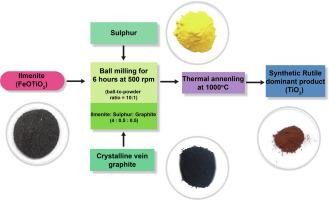Minerals Engineering ( IF 4.8 ) Pub Date : 2021-09-14 , DOI: 10.1016/j.mineng.2021.107197 H.C.S. Subasinghe 1 , Amila Sandaruwan Ratnayake 1

|
Sri Lanka is a major global producer of raw material-heavy minerals from beach placer deposits. This study focusses on upgrading Sri Lankan ilmenite sands to synthetic rutile via a mechanochemical method. Ball milling-induced sulphurisation and carbothermic reductions were examined using several geochemical techniques. Raw ilmenite concentrate contained over 95 wt% FeTiO3, ∼2 wt% SiO2, and ∼ 1 wt% Al2O3. Ilmenite was mixed with additives (i.e. sulphur, vein graphite, and a 1:1 mix of sulphur and vein graphite), separately in three ratios by weight, namely 1:1, 2:1 and 4:1, respectively. Each mixture was milled for 4 and 6 h. A high percentage of ilmenite/sulphur + graphite (ISG) was converted to nanoparticles (average particle size = 124 nm) in samples milled for 6 h. X-ray diffraction (XRD) spectra indicate that the intensities of sulphur and graphite peaks decrease after ball milling. This suggests possible dissolution of sulphur and graphite into the ilmenite structure, with the formation of mixed composite structures. The optimum ilmenite to additives ratio for ilmenite to rutile conversion was found to be 4:1. The occurrence of pyrite and pseudorutile peaks in XRD spectra of milled samples indicates that ilmenite reduction was initiated during ball milling. Fourier-transform infrared (FTIR) spectra of milled samples confirm the octahedral metal-ion stretching vibrations of carbon-incorporated ilmenite structures. The ilmenite-additive mixtures containing both sulphur and graphite (ISG) showed the best results. Consequently, ISG samples (mixing ratio of 4:0.5:0.5, and milled for 6 h) were isothermally annealed at 800 °C, 1000 °C and 1200 °C, respectively. Sharpening of rutile peaks and disappearance of pyrrhotite peaks in the annealed samples indicated the completion of the mechanochemical reactions that were initiated during ball milling. The optimum temperature for ilmenite reduction was determined to be 1000 °C. At that temperature pseudorutile peaks had disappeared from the XRD spectra of the annealed samples, whereas brookite and rutile peaks appeared. The method introduced in this study thus can be utilised to convert ilmenite to synthetic rutile.
中文翻译:

使用球磨诱导硫化和碳热还原将钛铁矿加工成合成金红石
斯里兰卡是来自海滩砂矿床的原材料重矿物的全球主要生产国。本研究的重点是通过机械化学方法将斯里兰卡钛铁矿砂升级为合成金红石。使用几种地球化学技术检查了球磨诱导的硫化和碳热还原。粗钛铁矿精矿含有超过 95%(重量)的 FeTiO 3、~2%(重量)的 SiO 2和~1%(重量)的 Al 2 O 3. 钛铁矿与添加剂(即硫、脉状石墨以及硫和脉状石墨的 1:1 混合物)分别以三种重量比分别混合,即 1:1、2:1 和 4:1。将每种混合物研磨 4 小时和 6 小时。在研磨 6 小时的样品中,高百分比的钛铁矿/硫+石墨 (ISG) 转化为纳米颗粒(平均粒径 = 124 nm)。X 射线衍射 (XRD) 光谱表明,球磨后硫和石墨峰的强度降低。这表明硫和石墨可能溶解到钛铁矿结构中,形成混合复合结构。发现钛铁矿与金红石转化的最佳钛铁矿与添加剂比例为 4:1。研磨样品的 XRD 谱中黄铁矿和假金红石峰的出现表明钛铁矿在球磨过程中开始还原。研磨样品的傅里叶变换红外 (FTIR) 光谱证实了掺碳钛铁矿结构的八面体金属离子伸缩振动。含有硫和石墨 (ISG) 的钛铁矿添加剂混合物显示出最好的结果。因此,ISG 样品(混合比为 4:0.5:0.5,研磨 6 小时)分别在 800 °C、1000 °C 和 1200 °C 下等温退火。退火样品中金红石峰的锐化和磁黄铁矿峰的消失表明球磨过程中引发的机械化学反应已经完成。钛铁矿还原的最佳温度确定为 1000 °C。在该温度下,退火样品的 XRD 谱中假金红石峰已经消失,而板钛矿和金红石峰出现。因此,本研究中介绍的方法可用于将钛铁矿转化为合成金红石。



























 京公网安备 11010802027423号
京公网安备 11010802027423号